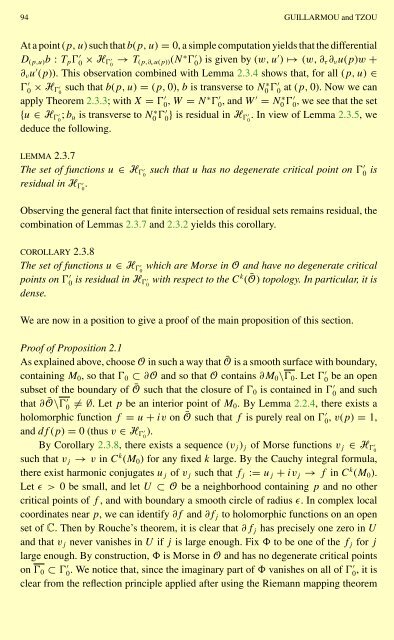NEAR OPTIMAL BOUNDS IN FREIMAN'S THEOREM
NEAR OPTIMAL BOUNDS IN FREIMAN'S THEOREM
NEAR OPTIMAL BOUNDS IN FREIMAN'S THEOREM
You also want an ePaper? Increase the reach of your titles
YUMPU automatically turns print PDFs into web optimized ePapers that Google loves.
94 GUILLARMOU and TZOU<br />
At a point (p, u) such that b(p, u) = 0, a simple computation yields that the differential<br />
D(p,u)b : TpƔ ′ 0 × HƔ ′ 0 → T(p,∂νu(p))(N ∗ Ɣ ′ 0 ) is given by (w, u′ ) ↦→ (w, ∂τ ∂νu(p)w +<br />
∂νu ′ (p)). This observation combined with Lemma 2.3.4 shows that, for all (p, u) ∈<br />
Ɣ ′ 0 × HƔ ′ 0 such that b(p, u) = (p, 0), b is transverse to N ∗ 0 Ɣ′ 0 at (p, 0). Now we can<br />
apply Theorem 2.3.3; with X = Ɣ ′ 0 , W = N ∗Ɣ ′ 0 ,andW ′ = N ∗ 0 Ɣ′ 0 , we see that the set<br />
{u ∈ HƔ ′ 0 ; bu is transverse to N ∗ 0 Ɣ′ 0 } is residual in HƔ ′ . In view of Lemma 2.3.5, we<br />
0<br />
deduce the following.<br />
LEMMA 2.3.7<br />
The set of functions u ∈ HƔ ′ 0 such that u has no degenerate critical point on Ɣ′ 0 is<br />
residual in HƔ ′ 0 .<br />
Observing the general fact that finite intersection of residual sets remains residual, the<br />
combination of Lemmas 2.3.7 and 2.3.2 yields this corollary.<br />
COROLLARY 2.3.8<br />
The set of functions u ∈ HƔ ′ 0<br />
points on Ɣ ′ 0 is residual in HƔ ′ 0 with respect to the Ck (<br />
dense.<br />
which are Morse in O and have no degenerate critical<br />
Ō) topology. In particular, it is<br />
We are now in a position to give a proof of the main proposition of this section.<br />
Proof of Proposition 2.1<br />
As explained above, choose O in such a way that Ō is a smooth surface with boundary,<br />
containing M0, sothatƔ0⊂∂O andsothatOcontains ∂M0\Ɣ0. LetƔ ′ 0 be an open<br />
and such<br />
subset of the boundary of Ō such that the closure of Ɣ0 is contained in Ɣ ′ 0<br />
that ∂Ō\Ɣ′ 0 =∅.Letpbe an interior point of M0. By Lemma 2.2.4, there exists a<br />
holomorphic function f = u + iv on Ō such that f is purely real on Ɣ′ 0 , v(p) = 1,<br />
and df (p) = 0 (thus v ∈ HƔ ′ 0 ).<br />
By Corollary 2.3.8, there exists a sequence (vj)j of Morse functions vj ∈ HƔ ′ 0<br />
such that vj → v in C k (M0) for any fixed k large. By the Cauchy integral formula,<br />
there exist harmonic conjugates uj of vj such that fj := uj + ivj → f in C k (M0).<br />
Let ɛ>0 be small, and let U ⊂ O be a neighborhood containing p andnoother<br />
critical points of f , and with boundary a smooth circle of radius ɛ. In complex local<br />
coordinates near p, we can identify ∂f and ∂fj to holomorphic functions on an open<br />
set of C. Then by Rouche’s theorem, it is clear that ∂fj has precisely one zero in U<br />
and that vj never vanishes in U if j is large enough. Fix to be one of the fj for j<br />
large enough. By construction, is Morse in O and has no degenerate critical points<br />
on Ɣ0 ⊂ Ɣ ′ 0 . We notice that, since the imaginary part of vanishes on all of Ɣ′ 0 ,itis<br />
clear from the reflection principle applied after using the Riemann mapping theorem

















